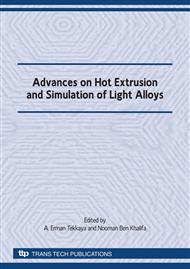[1]
V. Nagpal, T Altan: Analysis of the three dimensional metal flow in extrusion of shapes with the use of dual stream function in: Proceedings of the third North American Metal Research Conference on Pittsburgh, Pennsylvania, (1975), p.26.
Google Scholar
[2]
D. Y. Yang, C. H. Lee: Analysis of three dimensional extrusion of sections through curved dies by conformal transformation. International Journal of Mechanical Sciences, Vol. 29 (1978), pp.541-549.
DOI: 10.1016/0020-7403(78)90012-7
Google Scholar
[3]
C. H. Han, D.Y. Yang, M. Kiuchi: A new formulation for three-dimensional extrusion and its application to extrusion of clover sections. International Journal of Mechanical Science, Vol. 28 (1986), p.201.
DOI: 10.1016/0020-7403(86)90069-x
Google Scholar
[4]
F. Gatto, A Giardo: The characteristics of three-dimensional analysis of plastic deformation according to the SERR method. International Journal of Mechanical Science, Vol. 23 (1981), pp.129-138.
DOI: 10.1016/0020-7403(81)90025-4
Google Scholar
[5]
S. Hoshino, J. S. Gunasekara: An upper bound solution for extrusion of square section from round bar through converging dies. Proceedings of the 20th International Machine and Tool Design Research Conference, Vol. 21 (1980), p.97.
DOI: 10.1007/978-1-349-05861-7_14
Google Scholar
[6]
P. K. Kar, N. S. Das: Upper bound analysis of extrusion of I-section bars from square/rectangular billets through square dies. International Journal of Mechanical Science, Vol. 39 (1997), pp.925-934.
DOI: 10.1016/s0020-7403(96)00097-5
Google Scholar
[7]
P. K. Kar, R. K. Sahoo: An application of the SERR technique to the analysis of extrusion of sections from round billets. Journal of Institution of Engineers (India), Vol. 78 (1977), p.151154.
Google Scholar
[8]
J. S. Gunasekera, S. Hosino: Analysis of extrusion or drawing of polygonal sections through straightly conversing dies. J. Eng. Ind. Trans, ASME, Vol. 104 (1982), pp.38-45.
DOI: 10.1115/1.3185795
Google Scholar
[9]
J. L. Kuester, J. H. Mize: Optimization Techniques with Fortran. McGraw Hill Book Company.
Google Scholar
[10]
K. P. Maity, P. K. Kar, N. S. Das: A class of U-B solutions for the extrusion of square shapes from square billets through curved dies. Int. J. of Materials Processing Technology, Vol. 62 (1996), pp.185-190. 8.
DOI: 10.1016/0924-0136(95)02228-7
Google Scholar
[11]
R. Ponalagusamy, R. Narayanasamy P. Srinivasan: Design & Development of streamlined extrusion dies a Bezier curve approach. Int. J. of Materials Processing Technology, Vol. 161 (2005), pp.375-380.
DOI: 10.1016/j.jmatprotec.2003.08.005
Google Scholar
[12]
R. Narayanasamy, R. Ponalagusamy, R. Venkatesan, P. Srinivasan: An upper bound solution to extrusion of circular billet to circular shape through cosine dies. Int. J. of Materials and Design, Vol. 27 ( 2006), pp.411-415.
DOI: 10.1016/j.matdes.2004.11.026
Google Scholar


